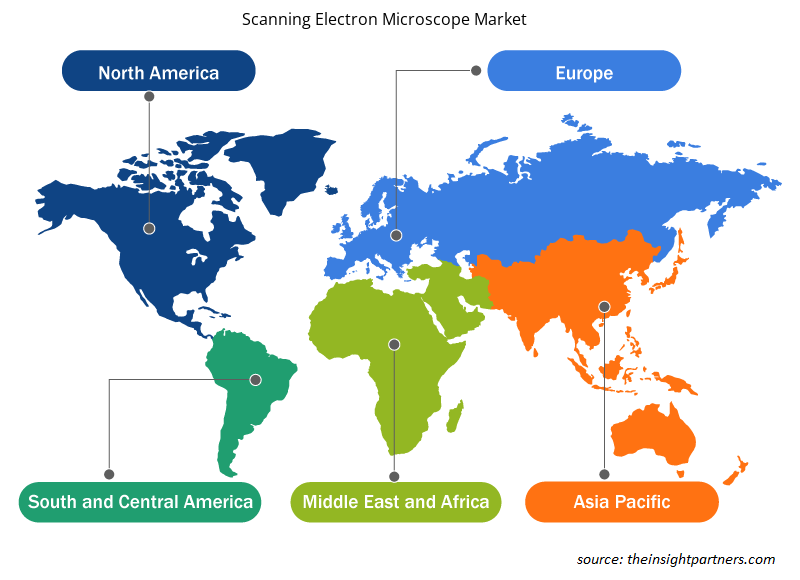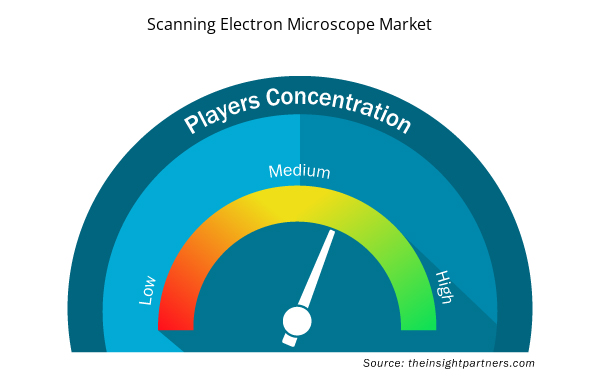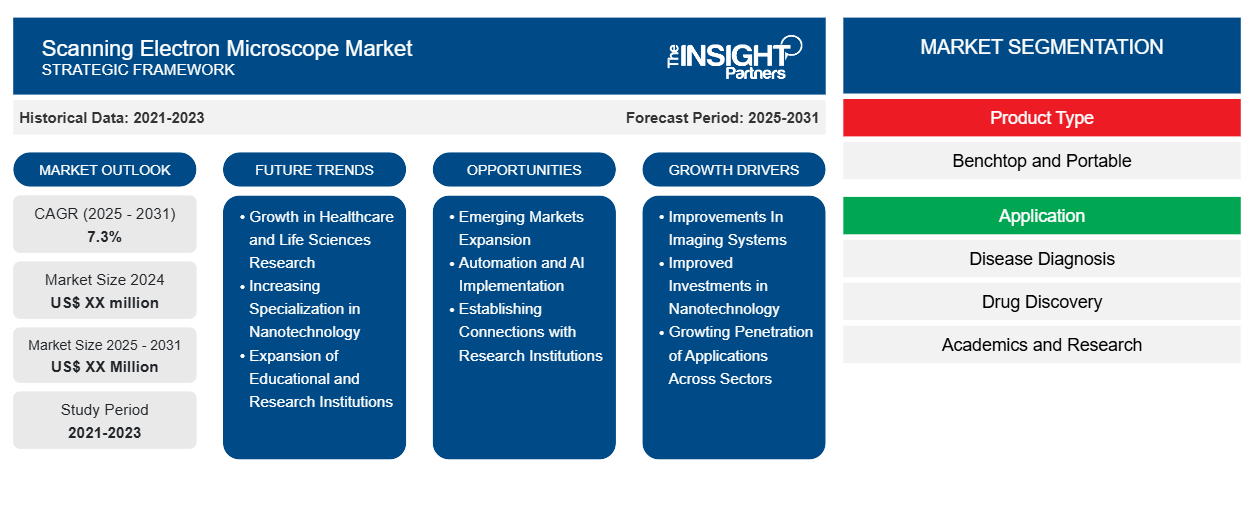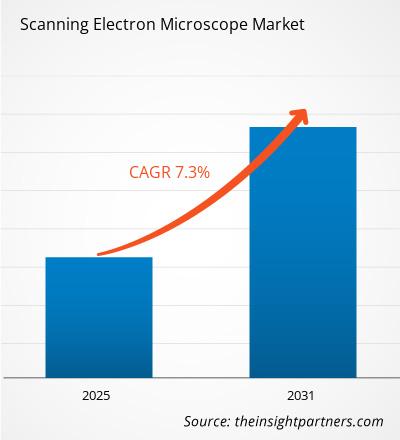Si prevede che il mercato dei microscopi elettronici a scansione registrerà un CAGR del 7,3% dal 2023 al 2031, con una dimensione di mercato in espansione da XX milioni di dollari nel 2023 a XX milioni di dollari entro il 2031.
Il rapporto presenta un'analisi basata sul tipo di prodotto (da banco e portatile). Il rapporto è segmentato per applicazione (diagnosi di malattie, scoperta di farmaci, accademici e ricerca). Il rapporto fornisce inoltre un'analisi basata sull'utente finale (aziende farmaceutiche e biotecnologiche, diagnostica e ricerca, istituti accademici, strutture sanitarie e altri). L'analisi globale è ulteriormente suddivisa a livello regionale e nei principali paesi. Le dimensioni del mercato e le previsioni a livello globale, regionale e nazionale per tutti i segmenti di mercato chiave sono coperte nell'ambito. Il rapporto offre il valore in USD per l'analisi e i segmenti di cui sopra. Il rapporto fornisce statistiche chiave sullo stato di mercato dei principali attori del mercato e offre tendenze e opportunità di mercato.
Scopo del rapporto
Il report Scanning Electron Microscope Market di The Insight Partners mira a descrivere il panorama attuale e la crescita futura, i principali fattori trainanti, le sfide e le opportunità. Ciò fornirà spunti a vari stakeholder aziendali, come:
- Fornitori/produttori di tecnologia: per comprendere le dinamiche di mercato in evoluzione e conoscere le potenziali opportunità di crescita, consentendo loro di prendere decisioni strategiche informate.
- Investitori: condurre un'analisi completa delle tendenze in merito al tasso di crescita del mercato, alle proiezioni finanziarie del mercato e alle opportunità esistenti lungo la catena del valore.
- Enti di regolamentazione: regolamentano le politiche e le attività di controllo sul mercato allo scopo di ridurre al minimo gli abusi, preservare la fiducia degli investitori e sostenere l'integrità e la stabilità del mercato.
Segmentazione del mercato dei microscopi elettronici a scansione
Tipo di prodotto
- Da banco e portatile
Applicazione
- Diagnosi della malattia
- Scoperta di farmaci
- Accademici e ricerca
Utente finale
- Aziende farmaceutiche e biotecnologiche
- Laboratori di Diagnostica e Ricerca
- Istituti accademici
- Strutture sanitarie
- Altri
Geografia
- America del Nord
- Europa
- Asia-Pacifico
- America del Sud e Centro
- Medio Oriente e Africa
Geografia
- America del Nord
- Europa
- Asia-Pacifico
- America del Sud e Centro
- Medio Oriente e Africa
Personalizza questo report in base alle tue esigenze
Riceverai la personalizzazione gratuita di qualsiasi report, comprese parti di questo report, o analisi a livello nazionale, pacchetto dati Excel, oltre a usufruire di grandi offerte e sconti per start-up e università
- Scopri le principali tendenze di mercato in questo rapporto.Questo campione GRATUITO includerà analisi di dati che spaziano dalle tendenze di mercato alle stime e alle previsioni.
Fattori di crescita del mercato dei microscopi elettronici a scansione
- Miglioramenti nei sistemi di imaging: i progressi nella tecnologia dei microscopi elettronici a scansione (SEM), come risoluzione migliorata, imaging più veloce e design intuitivi, sono diventati più attraenti sia per i ricercatori che per i produttori. Questi includono innovazioni mirate a una migliore analisi e visualizzazione dei dati, che incoraggiano più consumatori, quindi, un impatto positivo sul mercato.
- Investimenti migliorati in nanotecnologia: l'allocazione dei fondi verso iniziative di ricerca orientate alla nanotecnologia è un altro fattore importante che contribuisce alla crescita del mercato SEM. Con il crescente impegno di istituzioni governative e private verso programmi di nanotecnologia, il mercato sarà guidato dalla crescente necessità di strumenti di microscopia avanzati, tra cui SEM, per gli acquisti, facilitando così un'ulteriore crescita del mercato.
- Crescente penetrazione di applicazioni in tutti i settori: la capacità dei SEM di essere efficaci in molti settori, inclusi ma non limitati a, scienza dei materiali, elettronica, prodotti farmaceutici e gestione ambientale, aiuta nella crescita positiva del settore. Questa ampia applicabilità sta anche alimentando la domanda poiché sempre più settori stanno apprezzando l'importanza dei SEM nell'analisi e nella garanzia della qualità dei materiali.
Tendenze future del mercato dei microscopi elettronici a scansione
- Crescita nella ricerca in ambito sanitario e delle scienze della vita: c'è un'influenza schiacciante dello sviluppo del settore sanitario sulle attività di ricerca e sviluppo nell'ambito delle scienze della vita. Ad esempio, i microscopi elettronici a scansione sono ampiamente utilizzati negli studi biologici, in cui forniscono immagini ad alta risoluzione di cellule e tessuti. Si prevede che questa inclinazione stimoli ulteriormente le vendite nel reparto sanitario.
- Crescente specializzazione nella nanotecnologia: uno dei principali fattori che spinge il mercato SEM è il crescente livello di sofisticazione nella nanotecnologia. Prodotti più precisi e miniaturizzati sono richiesti dalle industrie e quindi la necessità di tecniche di imaging più raffinate per la valutazione dei materiali a livello di nanoscala è in aumento. Questa tendenza è destinata ad aumentare la crescita nel mercato dei microscopi elettronici a scansione, specialmente nei dipartimenti di R e S.
- Espansione di istituti di istruzione e ricerca: l'emergere di nuove strutture di istruzione e ricerca, soprattutto nei paesi in via di sviluppo, aumenta la crescita del mercato per gli strumenti avanzati per microscopi. Questa è una strategia di crescita che i produttori dovrebbero considerare, poiché questo segmento di mercato ha diversi requisiti di ricerca che possono essere affrontati con prodotti specifici.
Opportunità di mercato del microscopio elettronico a scansione
- Espansione dei mercati emergenti: c'è una tendenza crescente a stabilire unità di ricerca e sviluppo principalmente nei materiali e nelle scienze della vita nelle economie emergenti. Tali regioni possono essere sfruttate per cercare una collaborazione con questi centri e offrire loro attrezzature SEM specializzate per le loro esigenze.
- Implementazione di automazione e intelligenza artificiale: l'integrazione di implementazioni di automazione del posto di lavoro e intelligenza artificiale nei SEM aiuta a ridurre il processo di lavoro e a inserire dati corretti in modo accurato nell'output. L'enfasi deve essere posta sullo sviluppo di tali SEM che possono essere resi operativi in modo più user-friendly con funzionalità automatizzate che riducono al minimo i costi di laboratorio rendendo il prodotto più attraente per i possibili acquirenti.
- Creazione di connessioni con istituti di ricerca: sviluppare tali relazioni con college e organizzazioni di ricerca può portare alla progettazione di soluzioni specifiche per i SEM dedicati. Il coinvolgimento di istituti di ricerca può anche portare allo svolgimento di attività di ricerca congiunte che potenziano l'immagine del produttore e attraggono ulteriori clienti.
Approfondimenti regionali sul mercato dei microscopi elettronici a scansione
Le tendenze regionali e i fattori che influenzano il mercato dei microscopi elettronici a scansione durante il periodo di previsione sono stati ampiamente spiegati dagli analisti di Insight Partners. Questa sezione discute anche i segmenti e la geografia del mercato dei microscopi elettronici a scansione in Nord America, Europa, Asia Pacifico, Medio Oriente e Africa e America meridionale e centrale.

- Ottieni i dati specifici regionali per il mercato dei microscopi elettronici a scansione
Ambito del rapporto di mercato del microscopio elettronico a scansione
| Attributo del report | Dettagli |
|---|---|
| Dimensioni del mercato nel 2023 | XX milioni di dollari USA |
| Dimensioni del mercato entro il 2031 | XX milioni di dollari USA |
| CAGR globale (2023-2031) | 7,3% |
| Dati storici | 2021-2022 |
| Periodo di previsione | 2024-2031 |
| Segmenti coperti | Per tipo di prodotto
|
| Regioni e Paesi coperti | America del Nord
|
| Leader di mercato e profili aziendali chiave |
|
Densità degli attori del mercato dei microscopi elettronici a scansione: comprendere il suo impatto sulle dinamiche aziendali
Il mercato dei microscopi elettronici a scansione sta crescendo rapidamente, spinto dalla crescente domanda degli utenti finali dovuta a fattori quali l'evoluzione delle preferenze dei consumatori, i progressi tecnologici e una maggiore consapevolezza dei vantaggi del prodotto. Con l'aumento della domanda, le aziende stanno ampliando le loro offerte, innovando per soddisfare le esigenze dei consumatori e capitalizzando sulle tendenze emergenti, il che alimenta ulteriormente la crescita del mercato.
La densità degli operatori di mercato si riferisce alla distribuzione di aziende o società che operano in un particolare mercato o settore. Indica quanti concorrenti (operatori di mercato) sono presenti in un dato spazio di mercato in relazione alle sue dimensioni o al valore di mercato totale.
Le principali aziende che operano nel mercato dei microscopi elettronici a scansione sono:
- Società Bruker
- Microingegneria danese
- Società FEI
- Società di tecnologie elevate Hitachi
- Società a responsabilità limitata
Disclaimer : le aziende elencate sopra non sono classificate secondo un ordine particolare.

- Ottieni una panoramica dei principali attori del mercato dei microscopi elettronici a scansione
Punti chiave di vendita
- Copertura completa: il rapporto copre in modo completo l'analisi di prodotti, servizi, tipologie e utenti finali del mercato dei microscopi elettronici a scansione, fornendo una panoramica olistica.
- Analisi degli esperti: il rapporto è compilato sulla base della conoscenza approfondita di esperti e analisti del settore.
- Informazioni aggiornate: il rapporto garantisce la pertinenza aziendale grazie alla copertura di informazioni recenti e tendenze nei dati.
- Opzioni di personalizzazione: questo report può essere personalizzato per soddisfare le esigenze specifiche del cliente e adattarsi in modo appropriato alle strategie aziendali.
Il rapporto di ricerca sul mercato dei microscopi elettronici a scansione può, quindi, aiutare a guidare il percorso di decodifica e comprensione dello scenario del settore e delle prospettive di crescita. Sebbene possano esserci alcune preoccupazioni valide, i vantaggi complessivi di questo rapporto tendono a superare gli svantaggi.
- Analisi storica (2 anni), anno base, previsione (7 anni) con CAGR
- Analisi PEST e SWOT
- Valore/volume delle dimensioni del mercato - Globale, regionale, nazionale
- Industria e panorama competitivo
- Set di dati Excel


- Intraoperative Neuromonitoring Market
- Workwear Market
- Bioremediation Technology and Services Market
- Environmental Consulting Service Market
- Dry Eye Products Market
- Visualization and 3D Rendering Software Market
- GNSS Chip Market
- Automotive Fabric Market
- Investor ESG Software Market
- Molecular Diagnostics Market

Report Coverage
Revenue forecast, Company Analysis, Industry landscape, Growth factors, and Trends

Segment Covered
This text is related
to segments covered.

Regional Scope
North America, Europe, Asia Pacific, Middle East & Africa, South & Central America

Country Scope
This text is related
to country scope.
Domande frequenti
The final report will duly include market size and projection estimates for all the segments from 2021 to 2031, along with a revenue share and compound annual growth rate (%) for the regional/country-wise market wherein 2021-2022 are the historic years, 2023 is considered to be the base year, and the forecast will be provided till 2031, along with CAGR (%)
The market is expected to grow at a CAGR of 14.7%
The North America region accounts for highest revenue share scanning electron microscope market.
Asia Pacific is estimated to grow at the highest CAGR over the forecast year (2023 - 2031)
Nano3D Biosciences, Inc, Envisiontec GmbH, Organovo Holdings, Inc, Cyfuse Biomedical K.K, Regenhu Ltd, Aspect Biosystems Ltd, Cellink AB, Regenovo Biotechnology Co., Ltd, 3Dynamic Systems Ltd., Poietis are the some of the key market players operating in the 3D bioprinting market
Increasing prevelance of chronic disorders resulting organ transplant is the major factors boosting the scanning electron microscope market growth.
- Bruker Corporation
- Danish Micro Engineering
- FEI Company
- Hitachi High Technologies Corporation
- JEOL Ltd
- Leica Microsystems
- Nanoscience Instruments, Inc
- Nikon Corporation
- Carl Zeiss
- Olympus Corporation
The Insight Partners performs research in 4 major stages: Data Collection & Secondary Research, Primary Research, Data Analysis and Data Triangulation & Final Review.
- Data Collection and Secondary Research:
As a market research and consulting firm operating from a decade, we have published and advised several client across the globe. First step for any study will start with an assessment of currently available data and insights from existing reports. Further, historical and current market information is collected from Investor Presentations, Annual Reports, SEC Filings, etc., and other information related to company’s performance and market positioning are gathered from Paid Databases (Factiva, Hoovers, and Reuters) and various other publications available in public domain.
Several associations trade associates, technical forums, institutes, societies and organization are accessed to gain technical as well as market related insights through their publications such as research papers, blogs and press releases related to the studies are referred to get cues about the market. Further, white papers, journals, magazines, and other news articles published in last 3 years are scrutinized and analyzed to understand the current market trends.
- Primary Research:
The primarily interview analysis comprise of data obtained from industry participants interview and answers to survey questions gathered by in-house primary team.
For primary research, interviews are conducted with industry experts/CEOs/Marketing Managers/VPs/Subject Matter Experts from both demand and supply side to get a 360-degree view of the market. The primary team conducts several interviews based on the complexity of the markets to understand the various market trends and dynamics which makes research more credible and precise.
A typical research interview fulfils the following functions:
- Provides first-hand information on the market size, market trends, growth trends, competitive landscape, and outlook
- Validates and strengthens in-house secondary research findings
- Develops the analysis team’s expertise and market understanding
Primary research involves email interactions and telephone interviews for each market, category, segment, and sub-segment across geographies. The participants who typically take part in such a process include, but are not limited to:
- Industry participants: VPs, business development managers, market intelligence managers and national sales managers
- Outside experts: Valuation experts, research analysts and key opinion leaders specializing in the electronics and semiconductor industry.
Below is the breakup of our primary respondents by company, designation, and region:

Once we receive the confirmation from primary research sources or primary respondents, we finalize the base year market estimation and forecast the data as per the macroeconomic and microeconomic factors assessed during data collection.
- Data Analysis:
Once data is validated through both secondary as well as primary respondents, we finalize the market estimations by hypothesis formulation and factor analysis at regional and country level.
- Macro-Economic Factor Analysis:
We analyse macroeconomic indicators such the gross domestic product (GDP), increase in the demand for goods and services across industries, technological advancement, regional economic growth, governmental policies, the influence of COVID-19, PEST analysis, and other aspects. This analysis aids in setting benchmarks for various nations/regions and approximating market splits. Additionally, the general trend of the aforementioned components aid in determining the market's development possibilities.
- Country Level Data:
Various factors that are especially aligned to the country are taken into account to determine the market size for a certain area and country, including the presence of vendors, such as headquarters and offices, the country's GDP, demand patterns, and industry growth. To comprehend the market dynamics for the nation, a number of growth variables, inhibitors, application areas, and current market trends are researched. The aforementioned elements aid in determining the country's overall market's growth potential.
- Company Profile:
The “Table of Contents” is formulated by listing and analyzing more than 25 - 30 companies operating in the market ecosystem across geographies. However, we profile only 10 companies as a standard practice in our syndicate reports. These 10 companies comprise leading, emerging, and regional players. Nonetheless, our analysis is not restricted to the 10 listed companies, we also analyze other companies present in the market to develop a holistic view and understand the prevailing trends. The “Company Profiles” section in the report covers key facts, business description, products & services, financial information, SWOT analysis, and key developments. The financial information presented is extracted from the annual reports and official documents of the publicly listed companies. Upon collecting the information for the sections of respective companies, we verify them via various primary sources and then compile the data in respective company profiles. The company level information helps us in deriving the base number as well as in forecasting the market size.
- Developing Base Number:
Aggregation of sales statistics (2020-2022) and macro-economic factor, and other secondary and primary research insights are utilized to arrive at base number and related market shares for 2022. The data gaps are identified in this step and relevant market data is analyzed, collected from paid primary interviews or databases. On finalizing the base year market size, forecasts are developed on the basis of macro-economic, industry and market growth factors and company level analysis.
- Data Triangulation and Final Review:
The market findings and base year market size calculations are validated from supply as well as demand side. Demand side validations are based on macro-economic factor analysis and benchmarks for respective regions and countries. In case of supply side validations, revenues of major companies are estimated (in case not available) based on industry benchmark, approximate number of employees, product portfolio, and primary interviews revenues are gathered. Further revenue from target product/service segment is assessed to avoid overshooting of market statistics. In case of heavy deviations between supply and demand side values, all thes steps are repeated to achieve synchronization.
We follow an iterative model, wherein we share our research findings with Subject Matter Experts (SME’s) and Key Opinion Leaders (KOLs) until consensus view of the market is not formulated – this model negates any drastic deviation in the opinions of experts. Only validated and universally acceptable research findings are quoted in our reports.
We have important check points that we use to validate our research findings – which we call – data triangulation, where we validate the information, we generate from secondary sources with primary interviews and then we re-validate with our internal data bases and Subject matter experts. This comprehensive model enables us to deliver high quality, reliable data in shortest possible time.


 Ottieni un campione gratuito per questo repot
Ottieni un campione gratuito per questo repot